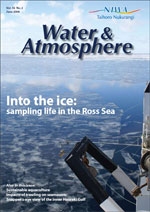PDF of this article (77 KB)

Fisheries scientist K. Radway Allen, 1911–2008

The Allen Building, home to marine fisheries research at NIWA’s Wellington campus, was named after Kenneth Radway Allen, who died recently in Australia, aged 97. I think we can rank Allen as the first professionally trained fisheries biologist employed by the New Zealand Government.
A native of Great Britain and graduate of Cambridge University, Allen came to New Zealand in 1938 to work for the Marine Department, which managed all fisheries in New Zealand apart from freshwater angling, an activity controlled by the acclimatisation societies. The Marine Department had turbulent relationships with the acclimatisation societies; Allen would have known little about this before coming to New Zealand, though he would quickly have found out.
Allen set to work on the trout population in the Horokiwi Stream, north of Wellington. He attempted to understand energy flow from the stream insects to the trout population that preyed on them and to develop an energy budget. It was an ambitious project, and there are stories of Allen and his wife dragging nets through the pools in the Horokiwi. The outcome, a book-sized bulletin published in 1951, remained Allen’s major work. He found that there wasn’t enough energy in the food web in the Horokiwi to support the stream’s trout population, a situation that would later become known as ‘Allen’s paradox’.
By the 1960s, Allen had become research director at the Fisheries Laboratory of the Marine Department. During his New Zealand career, he was a founder of the New Zealand Ecological Society and its first president, and was elected Fellow of the Royal Society of New Zealand in 1961.
In 1964, utterly frustrated by unhelpful senior bureaucrats in the Marine Department, Allen left for Canada, eventually becoming director of the fisheries research station in Nanaimo, British Columbia. In 1972, he shifted to Cronulla, New South Wales, as Director of the CSIRO Division of Fisheries and Oceanography, a position he held until retirement in 1977. He also became involved in management of international whale fisheries and was Chairman of the International Whaling Commission’s Scientific Committee from 1974 to 1979.
Following his departure to Canada, Allen’s New Zealand connections were slight, though he was marginally involved in a repeat study of the Horokiwi (now Horokiri) Stream. This study showed that the stream’s trout population was defunct, owing to the effects of the management of the stream’s catchment. The report on this work in 2000 was probably his last publication.
Bob McDowall
Allen, K.R. (1951). The Horokiwi Stream – a study of a trout population. New Zealand Marine Department. Fisheries Bulletin 10. 231 p.
For further information, contact: Dr Bob McDowall, 0-3-343 7861, [email protected]
Time to wet the whistle: researching Waikato drought

From February to June, NIWA in Hamilton hosted two visiting professors from Waterloo, Ontario: Dr Sherry Schiff (University of Waterloo) and Dr Michael English (Wilfrid Laurier University). This husband and wife team combines his expertise in hydrology and hers in biogeochemistry. They chose to spend their sabbatical in the Waikato because of ready access to the nearby Whatawhata Research Centre, where NIWA has, for many years, been running experimental work on rainfall effects and streams in hilly catchments. Whatawhata offers an infrastructure of experimental treatments, weirs, and monitoring structures supported by a decade of data.
Taking advantage of the unusual climatic conditions, they successfully monitored for nitrogen losses from the first storms after the extended Waikato drought and compared these among various land-use treatments. This research will provide information on the importance of catching the drought-breaking ‘first flush’ for accurate nitrogen (N) load measurement from rural catchments. Samples for N isotopes in water and vegetation will be analysed in Canada to help unravel the sources and flowpaths of N entering the streams under storm and baseflow conditions.
Says their NIWA host John Quinn, “Sherry and Michael have been a real pleasure to work with. Not only are they a self supporting research team, but they even supplied lab work through their home institutions. Now we’re getting sampling devices constructed based on their designs that we’ll use at other catchment study sites at Toenepi and Lake Taupo. We're also making plans for longer-term collaborations, potentially involving their graduate students doing research at our sites.”
Michael and Sherry comment, “Our NIWA visit has been greatly facilitated by the excellent NIWA staff. Many thanks to John for hosting us and to everyone who made our visit so productive and enjoyable. Working at NIWA and exploring New Zealand has been an amazing opportunity for ourselves and our children. New Zealand is a beautiful, fortunate country and there is much that we will miss about its people and its landscape.”
For further information, contact: Dr John Quinn, 0-7-856 6735, [email protected]
